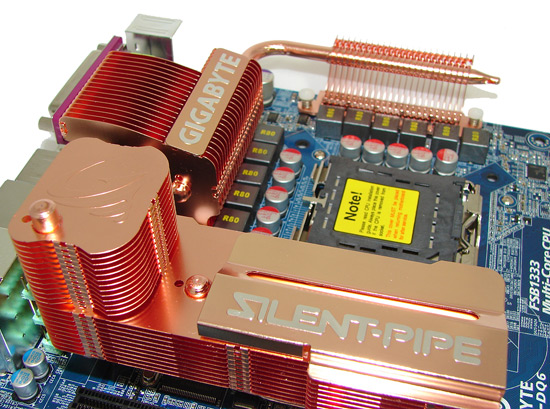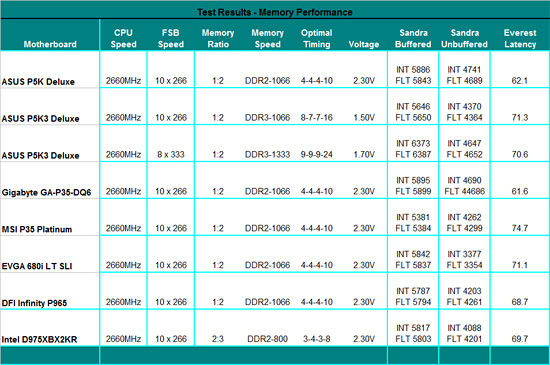Intel P35: Intel's Mainstream Chipset Grows Up
by Gary Key & Wesley Fink on May 21, 2007 3:45 PM EST- Posted in
- CPUs
Test Setup
| Standard Test Bed - CrossFire Test Configuration | |
| Processor | Intel Core 2 Duo QX6700 (2.66GHz, 8MB Unified Cache) |
| RAM | OCZ Reaper PC2-9200 (4x1GB) DDR2 4-4-4-10 Corsair CM3X1024 (4x1GB) DDR3-1066 8-7-7-16 |
| Hard Drive | Western Digital 150GB 10,000RPM SATA 16MB Buffer |
| System Platform Drivers | Intel - 8.3.0.1013 |
| Video Cards | 1 x MSI HD2900XT |
| Video Drivers | ATI 8.37.4.3 (HD2900XT Release Drivers) |
| CPU Cooling | Tuniq 120 |
| Power Supply | OCZ ProXStream 1000W |
| Optical Drives | Plextor PX-760A, Plextor PX-B900A |
| Case | Cooler Master CM Stacker 830 |
| Motherboards | Intel D975XBX2KR (Intel 975X) - BIOS 2692 ASUS P5K Deluxe (Intel P35) - BIOS 0304 ASUS P5K3 Deluxe (Intel P35) - BIOS 0011 MSI P35 Platinum (Intel P35) - BIOS 7345P01 Gigabyte P35-DQ6 (Intel P35) - BIOS F4 DFI Infinity P965 (Intel P965) - BIOS 424 EVGA 680i LT SLI (NVIDIA 680i LT) - BIOS P04 |
| Operating System | Windows Vista 64-bit Ultimate |
| . | |
Test conditions were maintained the same, as much as possible, over the platforms tested. Our game tests were run at settings of 1280x1024 HQ to ensure our GPU was not a bottleneck during testing. We will provide CrossFire results in our upcoming P35 roundup but preview performance numbers are available in this article.
All results are reported in our charts and color-coded for easier identification of results. We utilize new drive images on each board in order to minimize any potential driver conflicts. Our 3DMark results are generated utilizing the standard benchmark resolution for each program. We run each benchmark five times, throw out the two low and high scores, and report the remaining score. All results are run at stock speeds for this article although we will provide overclocked results in the next article.
Our choice of software applications to test is based on programs that enjoy widespread use and produce repeatable and consistent results during testing. Microsoft Vista has thrown a monkey wrench into testing as the aggressive nature of the operating system to constantly optimize application loading and retrieval from memory or the storage system presents some interesting obstacles. This along with the lack of driver maturity will continue to present problems in the near future with benchmark selections. Our normal process was to change our power settings to performance, delete the contents of the prefetch folder, and then reboot after each benchmark run. This is a lengthy process to be sure, but it results in consistency over the course of benchmark testing. All applications were run with administer privileges.

The test results we will present today are preliminary. What do we mean by this? Although the boards we are reviewing are full retail kits, their BIOS tuning continues at a rapid pace before the "official" launch on June 4th. Over the course of the last week we have tested numerous BIOS releases from each manufacturer and we've seen positive steps along the way. We honestly thought this preview would be a cake walk for ASUS until Gigabyte/MSI provided their latest BIOS releases that improved the performance of the boards up to 9% in certain areas.
We are also using early DDR3-1066 samples with memory settings at 8-7-7-16 for 1066 scores and 9-9-9-24 for DDR3-1333 results. We just received lower latency DDR3-1333 modules and will update our results in the roundup. On a side note, ASUS provided us a new BIOS for their P5K3 board that enables 1T command rates at DDR3-1066. Early testing has shown performance improvements up to 4% in memory sensitive applications. ASUS is continuing to work on the command rate timings and hopes to have 1T settings ready when low latency DDR3-1333 hits the market shortly. Expect to see an exclusive on this memory and BIOS in the next few days.
Our Intel Intel D975XBX2KR will be at a slight disadvantage, but with memory speeds set to DDR2-800 we were able to run timings at 3-4-3-8 without issue. We did not include extensive overclocking results for the CPU or memory side as time did not permit us to run each processor series on each board for the full test suite. We received seven boards late last week and will have results on several of those along with full overclocking results before Computex starts. We will also compare P35 1333/1066 DDR2 against P965 1333/1066 at the same time. Our DFI Infinity P965 is the fastest P965 board in our labs and as such is a good match for comparison.
Memory Performance
 |
| Click to enlarge |
We switched to a 4GB memory configuration for this article and future motherboard tests. The P35 chipset proves to have the fastest memory performance and best latencies at stock speeds provided the BIOS is tuned properly. We still find the 975X to offer some of the fastest memory performance when overclocked provided you can change strap settings and have very good RAM.
We noticed an 11% difference in unbuffered memory speeds and a 7% difference in latencies on the ASUS P5K Deluxe board when comparing auto to manually adjusted BIOS settings using the same standard 4-4-4-10 memory timings. Our other boards are tuned to the best possible performance that still allows the board to complete our benchmark test suite. We did not compare DDR2-1333 to DDR3-1333 for the simple fact that we currently do not have any DDR2 memory capable of 1333 speeds in a stable manner. However, we do expect DDR2-1333 RAM later this summer.










58 Comments
View All Comments
Gary Key - Tuesday, May 22, 2007 - link
X38 is basically ready, going through some fine tuning now... I understand it will be held until after the 1333CPUs are launched and DDR3 availability is a little more widespread/cost effective. I expect late August right now, but you never know with Intel. ;-)JarredWalton - Monday, May 21, 2007 - link
Technically Q3 is any time between July 1 and September 30, but if they're saying Q3 right now it probably means some time in August at best.gigahertz20 - Monday, May 21, 2007 - link
I applaud ASUS for only including 1 legacy connection on their P5K series, and not 4 like Gigabyte has chosen to do for their P35 board. Death to legacy connections!I mean really, why even include those damn legacy ports. The enthusiast that buys one of these boards will not be using them, they are a waste of space. Instead of having them, they should replace them with more USB ports or something useful.
JarredWalton - Monday, May 21, 2007 - link
I still have a parallel based laser printer that works fine for what I need, and I'm quite happy using it until it dies. There are also people that use serial devices that cost a lot of money. I don't think every board needs legacy support, but it's good that there are still options for people that *need* certain legacy devices. I've got several KVM switches that won't be useful if PS/2 ports disappear. :(yacoub - Monday, May 21, 2007 - link
Don't they offer USB or eSATA to serial/parallel convertors for those sort of situations? :)JarredWalton - Monday, May 21, 2007 - link
Sure, but I haven't had the need to try one yet. :)Truth be told, my printer has a USB port, but it behaves very poorly using a USB connection. It's a Brother HL-1240, and if the printer isn't powered on when you boot, Windows won't see it unless you unplug it and plug it back into a different USB port. It just works better with LPT, and as I said for my needs it's sufficient. The way I figure it, having the ports there isn't hurting most people. I've never seen anything to indicate they hamper performance, and how many extra transistors are "wasted" on these ports? Maybe a few thousand? Heheh. 45M transistors on the P35 is a bit crazy....
For what it's worth, between mouse, keyboard, and my LCD (which actually has four USB ports and flash memory readers), I haven't had any need for more than four USB ports on a motherboard. But then, I've got too many PCs around anyway.
TA152H - Monday, May 21, 2007 - link
I agree with you, but for another reason.I don't like USB at all, because a few years ago I ran some tests, on motherboards ranging from MVP3 based to a KT880, and USB seems to have a negative impact on performance, particularly on memory, in many cases.
It doesn't make my keyboard work any better, or my mouse, and I'm not sure why I need it for those functions at all. PS/2 ports don't do it well enough? I'm not crazy about this one size fits all approach, especially when it comes with overhead. The current ports work fine.
USB is a crappy, bloated technology. I'm not sure the "S" should stand for "serial" at all, I think there is a better word that begins with S for it.
strikeback03 - Tuesday, May 22, 2007 - link
Wake me up when Bluetooth works over PS/2.Though one reason to still include PS/2 keyboard/mouse is that it is hard to screw up support for those in Linux kernels. Same can't be said about USB.
TA152H - Tuesday, May 22, 2007 - link
Wake me up when I need Bluetooth.You could implement Bluetooth easily if USB didn't exist, but you're missing the point anyway. When you have to use USB for stuff that is handled more efficiently by PS/2 ports, it's a bad thing. Or other ports. It adds no function for these devices, and comes with overhead. It's a bad idea, but of course Intel was in the mode of making as many things as possible use CPU power so they could keep selling their latest and greatest.
It's just a rehash of some dorky Apple stuff that most people here don't remember. The original MacIntoy didn't have any slots, and you'd attach stuff to some serial bus for expansion. Naturally, it didn't work out, and they had to add slots. At least they didn't get rid of slots for USB, they just made it bloated.
DigitalFreak - Monday, May 21, 2007 - link
Man, if the P35 boards are going to be around the $250 mark, I'm not looking forward to see the price on the X38 boards.... :-(